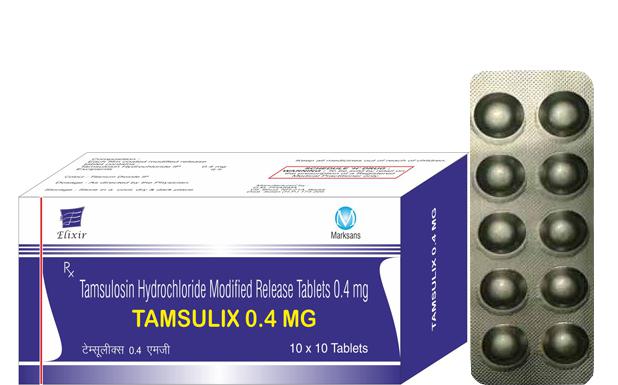Indications:
● Tamsulosin is used by men to treat the symptoms of an enlarged prostate (benign prostatic hyperplasia-BPH).
● Helps to relieve symptoms of BPH such as difficulty in beginning the flow of urine, weak stream, and the need to urinate often or urgently (including during the middle of the night).
Pharmacology:
Mechanism of Action:
The symptoms associated with benign prostatic hyperplasia (BPH) are related to bladder outlet obstruction, which is comprised of two underlying components: static and dynamic. The static component is related to an increase in prostate size caused, in part, by a proliferation of smooth musclecells in the prostatic stroma. However, the severity of BPH symptoms and the degree of urethral obstruction do not correlate well with the size of the prostate. The dynamic component is a function of an increase in smooth muscle tone in the prostate and bladder neck leading to constriction of the bladder outlet. Smooth muscle tone is mediated by the sympathetic nervous stimulation of alpha1 adrenoceptors, which are abundant in the prostate, prostatic capsule, prostatic urethra, and bladder neck. Blockade of these adrenoceptors can cause smooth muscles in the bladder neck and prostate to relax, resulting in an improvement in urine flow rate and a reduction in symptoms of BPH. Tamsulosin, an alpha1 adrenoceptor blocking agent, exhibits selectivity for alpha1 receptors in the human prostate. At least three discrete alpha1 adrenoceptor subtypes have been identified: alpha1A, alpha1B, and alpha1D; their distribution differs between human organs and tissue. Approximately 70% of the alpha1 receptors in the human prostate are of the alpha1A subtype.
Pharmacokinetics:
Absorption: Absorption of tamsulosin hydrochloride 0.4 mg is essentially complete (> 90%) following oral administration under fasting conditions. Tamsulosin hydrochloride exhibits linear kinetics following single and multiple dosing, with achievement of steady-state concentrations by the fifth day of once-a-day dosing.
Distribution: Tamsulosin hydrochloride is extensively bound to human plasma proteins (94% to 99%), primarily alpha1 acid glycoprotein (AAG), with linear binding over a wide concentration range (20 to 600 ng/mL).
Metabolism: There is no enantiomeric bioconversion from tamsulosin hydrochloride [R(-) isomer] to the S(+) isomer in humans. Tamsulosin hydrochloride is extensively metabolized by cytochrome P450 enzymes in the liver and less than 10% of the dose is excreted in urine unchanged. However, the pharmacokinetic profile of the metabolites in humans has not been established. Tamsulosin is extensively metabolized, mainly by CYP3A4 and CYP2D6 as well as via some minor participation of other CYP isoenzymes. Inhibition of hepatic drug-metabolizing enzymes may lead to increased exposure to tamsulosin.
Excretion: Tamsulosin hydrochloride undergoes restrictive clearance in humans, with a relatively low systemic clearance (2.88 L/h).
Interactions:
You should not use Tamsulosin 0.4mg if you:
● are allergic to tamsulosin or any ingredients in Tamsulosin
● have liver or kidney disease
● have a history of orthostatic hypotension (dizziness, weakness when standing up from sitting)
●are taking medications that interact with Tamsulosin including: other alpha-blockers that relaxes smooth muscle, the anti-inflammatory diclofenac, the anticoagulant warfarin, cimetidine for stomach ulcers.
Side Effects:
The most commonly reported side effects when taking Tamsulosin include: dizziness, headache, abnormal ejaculation, asthenia (weakness), and palpitations.
Dosage:
Tamsulosin 0.4 mg once daily is recommended as the dose for the treatment of the signs and symptoms of BPH. It should be administered approximately one-half hour following the same meal each day.
